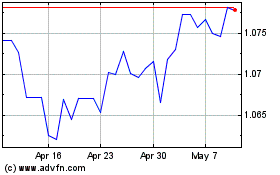Euro Rises After German Unemployment Data
April 30 2015 - 7:29AM
RTTF2
The euro strengthened against other major currencies in the
early European session on Thursday, as German Bund prices extended
its rise. The common currency rose further after data showed that
the German unemployment declined in April.
German government bond yields rose around 0.29 percent on
Wednesday, the highest since December 2013.
The improvement in the Eurozone bonds hints recovery in the
economy.
Meanwhile, the treasuries fell due to ECB's month bond-buying
stimulus program announced earlier this month.
The bonds were low after the European Central Bank announced its
quantitative-easing program in January. Markets expected the
10-year yields to fall into negative territory.
Data from the Federal Labor Agency showed that German
unemployment declined less than expected in April. The number of
people out of work declined by seasonally adjusted 8,000 to 2.79
million in April. It was forecast to fall by 15,000. The jobless
rate came in at a record low 6.4 percent, the same rate as seen in
March. In other economic news, data from Eurostat showed that
Eurozone consumer prices remained flat in April as expected by
economists after falling for four consecutive months. Consumer
prices dropped 0.1 percent in March and 0.3 percent in
February.
Eurozone unemployment rate remained unchanged for a second
straight month in March, at its lowest level in nearly three years.
The seasonally adjusted jobless rate was 11.3 percent, unchanged
from both February and January. Economists had forecast a decline
of 11.2 percent.
In the Asian trading, the Euro held steady against its major
rivals. In the European trading today, the euro rose to more than a
2-month high of 1.1247 against the U.S. dollar and nearly a 2-month
high of 133.71 against the yen, from early lows of 1.1070 and
131.29, respectively. If the euro extends its uptrend, it is likely
to find resistance around 1.17 against the greenback, and 137.50
against the yen. Moving away from early low of 0.7187 against the
pound, the euro climbed to more than a 2-week high of 0.7266. The
euro may test resistance near the 0.75 region. The euro edged up to
1.0506 against the Swiss franc, from an early low of 1.0429. On the
upside, 1.07 is seen as the next resistance level for the
franc.
Against the New Zealand, the Australia and the Canadian dollars,
the euro advanced to nearly a 2-month high of 1.4771, more than a
3-week high of 1.4148 and a 3-week high of 1.3506 from early lows
of 1.4471, 1.3859 and 1.3326, respectively. The euro is likely to
find resistance around 1.56 against the kiwi, 1.46 against the
aussie and 1.40 against the loonie.
Looking ahead, Canada GDP for February, U.S. weekly jobless
claims for the week ended April 25, U.S. personal income and
spending data for March are set to be published in the New York
session.
At 8:30 am ET, Federal Reserve Governor Daniel Tarullo will
deliver a speech titled "Tailoring Community Bank Regulation and
Supervision" at the Independent Community Bankers of America Policy
Summit in Washington DC.
At 10:30 am ET, BOC Governor Stephen Poloz will testify, along
with Senior Deputy Governor Carolyn Wilkins before the Senate
Finance Committee in Ottawa.
Euro vs US Dollar (FX:EURUSD)
Forex Chart
From Mar 2024 to Apr 2024

Euro vs US Dollar (FX:EURUSD)
Forex Chart
From Apr 2023 to Apr 2024
